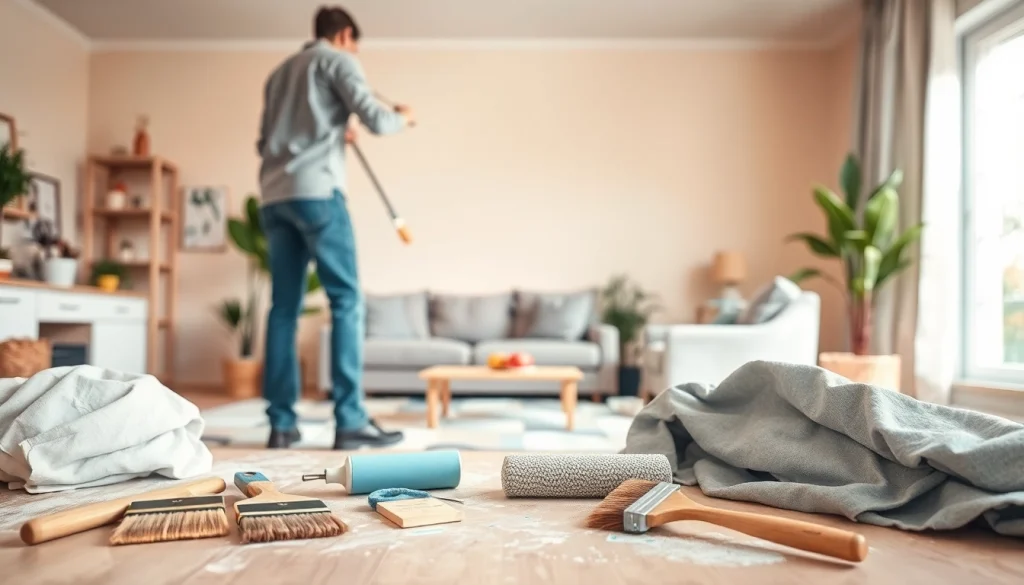Understanding Interior Painting: Key Concepts and Definitions
What is Interior Painting?
Interior painting encompasses the process of applying paint to the surfaces within a building, typically including walls, ceilings, doors, and trim. This task can vary greatly in scale and complexity, from a simple room refresh to the comprehensive painting of an entire house. When embarking on an interior painting project, it’s essential to understand the various types of paints available, the tools required, and the methods best suited for achieving a beautiful finish.
Importance of Interior Painting for Home Aesthetics
The aesthetic value of a home can be significantly enhanced through the right interior painting techniques. Freshly painted walls can rejuvenate a space, making it brighter, warmer, and more inviting. Moreover, a well-executed interior paint job can reflect the homeowner’s personality and style, turning an average room into a unique living environment. Beyond aesthetic appeal, paint also offers practical benefits, such as protecting walls from damage and moisture.
Types of Interior Paint Finishes Available
In the world of interior painting, understanding the various finishes is pivotal for selecting the right one for your space:
- Matte Finish: Offers a non-reflective surface that helps to hide imperfections but isn’t as durable against stains.
- Satin Finish: Blends durability with a soft sheen perfect for high-traffic areas like living rooms or hallways.
- Eggshell Finish: Similar to satin but slightly less glossy; it’s more washable and durable than matte.
- Glossy Finish: Highly reflective and easy to clean, typically used for trim and moldings.
Preparing for Your Interior Painting Project
Choosing the Right Color Scheme for Your Space
Color selection is one of the most crucial aspects of interior painting. Choosing the right colors can dramatically affect the ambiance of a room. Here are a few tips for selecting a harmonious color scheme:
- Consider Room Function: The purpose of the room can guide your color choices. Calming blues and greens work well in bedrooms, while lively yellows and oranges can energize a kitchen.
- Use Color Wheels: Tools like color wheels can help identify complementary colors and shades.
- Test Samples: Always sample colors on your walls before deciding. Light conditions change how hues appear, so test a few options to see how they feel at different times of the day.
Essential Tools and Materials for Interior Painting
Proper tools and materials are vital to achieving a professional finish. Here’s a brief list of what you’ll need:
- Paint (select based on finish type and color)
- Primer (for better adhesion and coverage)
- Brushes (various sizes for edges and details)
- Rollers and trays (for large surface areas)
- Painter’s tape (for edging)
- Drop cloths (to protect floors and furniture)
- Sandpaper and patching compound (for wall preparation)
How to Prepare Walls and Surfaces Before Painting
An excellent paint job starts with proper surface preparation. Here are steps to prepare your walls:
- Clean the Walls: Remove dust and dirt using a damp cloth. For greasy spots, use a mild detergent.
- Repair Any Imperfections: Fill holes and cracks with spackling compound; once dry, sand it smooth.
- Remove Old Paint: If necessary, scrape off old, flaking paint to ensure adhesion.
- Apply Primer: Especially for new drywall, applying a primer helps the paint adhere better and provides a uniform base.
Steps to Achieve a Professional Finish
The Best Techniques for Interior Painting
To achieve a smooth, professional-looking interior paint project, here are some tips and techniques:
- Start with the Ceiling: Always begin painting from the top down to avoid drips on finished surfaces.
- Use Painter’s Tape: Apply tape on edges to achieve clean lines where paint meets other surfaces.
- Utilize Proper Rolling Technique: Roll in a ‘W’ pattern for even coverage and minimal roller marks.
- Apply Thin Coats: Multiple thin layers are better than one thick coat, helping to avoid drips and uneven textures.
Common Mistakes to Avoid During Painting
Even with the best preparation and tools, common mistakes can derail your efforts:
- Skipping Primer: Failing to use primer can lead to uneven color and finish.
- Ignoring the Weather: Extreme temperatures can affect paint drying times and durability.
- Not Ventilating: Poor ventilation can lead to longer drying times and health hazards.
Final Touches: Effective Cleanup and Inspection
After painting, it’s essential to inspect your work thoroughly. Here’s what you should do:
- Inspect for Missed Spots: Check under good lighting for areas that may need touch-ups.
- Remove Painter’s Tape: Carefully pull away the tape while the paint is still wet to avoid peeling.
- Clean Up Tools: Clean brushes and rollers immediately after use to extend their life.
Cost Considerations for Interior Painting
Breaking Down the Cost of Materials and Labor
The cost of an interior painting project can vary significantly based on several factors:
- Paint Quality: The type of paint chosen impacts the overall budget significantly. Higher quality paints typically cost more but may require fewer coats and result in better durability.
- Surface Size: Larger rooms require more paint and longer labor hours, which could increase costs.
- Labor Costs: Hiring professionals can range widely, often owing to experience and region. It’s advisable to get multiple quotes to ensure a fair rate.
How Location Affects Interior Painting Costs
Costs can vary significantly depending on the location of your home. Urban areas typically see higher prices due to demand and cost of living. Additionally, regional labor rates influence the overall cost. Here are some examples based on location:
- California: Average $1,570 to paint a 12×12 room
- Florida: Average $1,130 for similar jobs
- Georgia: Average around $1,000
DIY vs. Hiring Professional Painters: Pros and Cons
Deciding between DIY and hiring professionals often depends on your budget, skill level, and desired outcome.
Pros of DIY:
- Cost Savings: Labor can be the most significant expense in a painting project.
- Flexibility: You can schedule the work according to your availability.
Cons of DIY:
- Time-Consuming: Painting can take longer than anticipated, especially if you are inexperienced.
- Professional Quality: Achieving a flawless finish can be challenging without experience.
Maintaining Your Newly Painted Interiors
Best Practices for Long-lasting Paint Results
To ensure the longevity of your newly painted surfaces, follow these best practices:
- Avoid Excessive Moisture: High humidity can lead to mold growth and paint damage.
- Regular Touch-ups: Address scuffs and scratches immediately to maintain aesthetics.
How to Clean and Care for Painted Surfaces
Cleaning painted walls requires a gentle touch to avoid damaging the finish:
- Use a soft cloth or sponge and mild, non-abrasive cleaners.
- For tough spots, consider using a diluted solution of vinegar and water.
When to Consider a Repaint: Signs to Watch For
Knowing when to repaint can save you from future headaches:
- Fading Colors: Sun exposure can bleach paint, leading to dullness.
- Peeling or Cracking: These issues indicate moisture problems and that it’s time to repaint.
- Stains: Persistent stains that can’t be cleaned effectively may necessitate a new coat.



